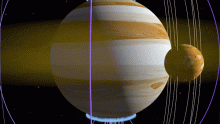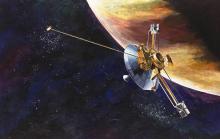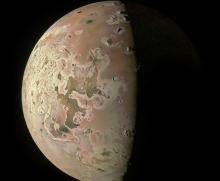Listen to today's episode of StarDate on the web the same day it airs in high-quality streaming audio without any extra ads or announcements. Choose a $8 one-month pass, or listen every day for a year for just $30.
You are here
Moon and Jupiter
How long does it take to give birth to a giant?
If the giant happens to be Jupiter or Saturn, about four million years, according to a recent study. Not only that, but the giant planets passed through their period of youthful wanderlust in that same time, settling pretty much where they are today by the end of it.
Researchers at MIT studied meteorites that are more than 4.6 billion years old, which means they were around during the solar system’s formation. The older of these meteorites preserve traces of a magnetic field that permeated the early solar system. But those that are a bit younger show almost no magnetic field.
According to the researchers, that means the solar nebula — the cloud of gas and dust that gave birth to the planets — lasted no more than four million years. By the end of that time, the Sun’s magnetic field had weakened, allowing the leftover material to dissipate.
Jupiter and Saturn grew so large in part by sweeping up vast amounts of material in the nebula. When the nebula vanished, they stopped growing.
And the gravity of the nebula had caused the giants to move inward and then back out — a process that also stopped when the nebula went away. That left Jupiter and Saturn pretty much at their current distances from the Sun.
And Jupiter is in great view tonight. The planet is shining at its brightest for the year. And it’s quite close to the full Moon, so you can’t miss it.
More about Jupiter and the Moon tomorrow.





